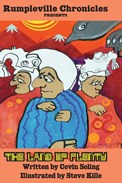
 |
In another rendition of satire and candid humor, Soling’s graphic novel has created a world where neighboring lands envy the Land of Plenty. Fitting to their name, these bordering lands are called the Land of Death, The Land of Pestilence, and the Land of Scarcely Anything at All Other than Misery and Depression. In this work, these lands are essentially the principal characters. They seek to dethrone the Land of Plenty and bring it to its knees.
Following a series of unsuccessful challenges, the remaining lands of Death, Pestilence, and Misery come together to form the Federation of Poverty. The federation thinks it has a foolproof plan when it enlists the Salvation Army to enter the Land of Plenty to ask for donations in Santa suits. Unfortunately for them, their campaign ends in abject disaster once again. This sets the scene for the ruling class, the Oligarchy of the Plenty. So, at the heart of the work is a tug-of-war between the “Poverts” and the “Plentenians,” one that humorously ends up in litigation, “plenty” of legal fees, and ultimately, collapse.
In classic “Solingian” fashion, the work is using its inclination toward the surreal and sublime to deliver strong commentary on the state of society. Far from anything that remotely resembles utopian living, it is intriguing to see the envy projected by death and pestilence while the Plentenians continue to hoard everything. Ultimately it is their having plenty of everything that ends up being their downfall. Soling’s work oozes creativity, and while one can predict what is going to happen, how the author will allow the plot to unravel to get to that point is entirely a mind-numbing maze.
Though the interpretation of the story is in the eye of the beholder, the resemblance between the greed and unwillingness to share from the Plentenians and the one percent of the world that has amassed eighty percent of its wealth and resources is downright eerie. The Salvation Army scene is brilliant as it is emblematic of service and charity in reality, yet it is an actual army of donation seekers in the work. It is this juxtaposition and play with reality and imagination that gives Soling’s work such an endearing quality while also providing a way for people to think and process complex issues without the strings of the real world bogging them down. Similarly, the imagery of fallen Plentenian enemies being used as organ donors earlier in the work is just as riveting an example of what power can do.
Overall, Soling’s work is imbued with cinematic qualities. Conjuring this work onto the big screen would certainly be eye-opening. The chess match between the Ambassador and the Oligarchy of the Plenty features a strategic gem of moves true to each side's own character and disposition (e.g., the Plentenians requesting plenty of lawyers to determine which of the ailments they should have). At the end of the day, it is one’s own vulnerabilities that bring us down, and Soling’s denouement proves just that. Ultimately, Soling’s work is clever and creative, a whimsical and playful tongue-in-cheek portrayal of modern society.
RECOMMENDED by the US Review